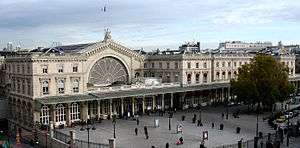Main line for Europe

The Main line for Europe (referred to as the Magistrale für Europa in German and Magistrale européenne in French) is a Trans-European Transport Networks (TEN-T) project for the creation of a high-speed railway line between Paris and Bratislava, with a branch-off to Budapest. It was listed as TEN project No. 17 (Paris—Bratislava) by the European Commission in 1995, and is already under way.[1]
The project is planned to be completed by 2020. It will link 34 million people in five European countries. The overall length of the route from Paris to Budapest is 1,592 km (989 mi).
Sections
Parts of the route were formerly served by Orient Express trains, which ceased operations in 2009. Today TGV rail connections exist from Paris to Stuttgart or at longest Munich. The Austrian Federal Railways (ÖBB) currently provide direct Railjet and EuroNight connections between Munich and Budapest.
France

The French part of the line is the LGV Est européenne high-speed railway. Its first section as far as Baudrecourt east of Metz has been in use since 2007 whilst the second section to Vendenheim near Strasbourg opened in July 2016.[2] The new railway line provides a maximum speed up to 320 km/h and reduced the travel time from Gare de Paris-Est to the largely refurbished Gare de Strasbourg to less than two hours.
Germany
In Germany the line follows the Appenweier–Strasbourg railway (Europabahn) from the Rhine Bridge to Appenweier and then the Mannheim–Karlsruhe–Basel railway (Rheintalbahn) down to Bruchsal. The Europabahn is built for a maximum speed of 200 km/h while the Rheintalbahn to Rastatt Süd is for 250 km/h. The second part of the new Rheintalbahn (Rastatt Süd to Bruchsal) is to be completed by 2014. At the Bruchsal Rollenberg junction the MoE joins the Mannheim–Stuttgart high-speed railway which was built for 250 km/h. Stuttgart Hauptbahnhof is to be rebuilt as a through station in the course of the controversial Stuttgart 21 project.

In Stuttgart the line joins the Stuttgart–Augsburg new and upgraded railway (including the Stuttgart–Wendlingen and Wendlingen–Ulm high-speed railway lines replacing the Fils Valley Railway) which is expected to be completed in 2020 and will provide a maximum speed of 250 km/h between Stuttgart and Ulm and 200 km/h on the Ulm–Augsburg railway line. The Munich–Augsburg railway is being upgraded to separate slower traffic (freight and short-distance trains) from high speed trains, which will be able to reach 230 km/h. From München-Pasing station trains may run directly to München Ost without passing München Hauptbahnhof. Plans for the reconstruction of the Munich main station similar to Stuttgart 21 have been abandoned.
Trains from München Ost shall reach Salzburg Hauptbahnhof via the upgraded Munich–Mühldorf railway, providing a maximum speed of 160 km/h, and the Mühldorf–Freilassing railway line. In Freilassing the MoE joins the Rosenheim–Salzburg railway leading across the Austrian border including a new third track serving the Salzburg S-Bahn commuter network.
Austria

In Austria, the Western Railway line is to be extended to reduce travel time between Munich, Salzburg, Linz, and Vienna to one hour each. The section between the Attnang-Puchheim rail hub and Wels Hauptbahnhof near Linz was already upgraded until October 2012 to provide a maximum speed of 230 km/h. Between Linz an Vienna a new parallel high-speed railway line (Neue Westbahn) for a maximum speed of 250 km/h is to be completed in 2015, including the Wienerwald Tunnel.
In Vienna, the former Südbahnhof terminal station was demolished and replaced by new Wien Hauptbahnhof. From here, trains run on the Eastern Railway line to Bratislava-Petržalka railway station, including a connection to Vienna International Airport. East of Vienna, a southwestern branch-off leads via Győr to Budapest.
Route
| Section | Distance | Opening | Duration before1 | Recent duration1 | Planned duration1 | ||
|---|---|---|---|---|---|---|---|
| Paris–Strasbourg | 476 km | Paris–Baudrecourt 2007 | 237 min | 110 min | - | ||
| Baudrecourt–Vendenheim 2016 | |||||||
| Strasbourg–Karlsruhe | 81 km | a portion (Appenweier-Karlsruhe) is in use now | 40 min | 25 min | |||
| Karlsruhe–Stuttgart | 90 km | in use | 61 min | 35 min | 35 min | ||
| Stuttgart–Ulm | 94 km today | 2022 | 54 min | 28 min | |||
| 81 km new | |||||||
| Ulm–Augsburg | 86 km | not before 2019 | 41 min | 28 min | |||
| Augsburg–Munich | 61 km | 2011 | 37 min | 18 min | |||
| Munich–Salzburg | 153 km | Munich–Freilassing 2015 | 87min | 62 min | |||
| Freilassing–Salzburg 2009 | |||||||
| Salzburg–Linz | 127 km | Salzburg–Attnang-Puchheim 2013 | 64 min | 60 min | |||
| Attnang-Puchheim–Wels 2011 | |||||||
| Wels–Linz 2015 | |||||||
| Linz–St. Pölten | 130 km | 2015 | 48 min | 45 min | |||
| St.Pölten-Vienna | 44 km | 2012 | 41 min | 25 min | |||
| Vienna–Budapest | 263 km | 181 min | |||||
| Vienna–Bratislava | northern line 65 km | 2011 | 57 min | 35 min | |||
| southern line 80 km | 2013 | 55 min | |||||
| total: | |||||||
| Paris–Budapest | 1592 km | 722 min (12:02)1 2 | 634 min (10:34)1 2 | ||||
| Paris–Bratislava (northern line) | 1394 km | 598 min (9:58)1 2 | 488 min (8:08)1 2 | ||||
| Paris–Bratislava (southern line) | 1409 km | 508 min (8:28)1 2 | |||||
| Paris–Munich | 875 km | 484 min (8:04)1 2 | 317 min (5:17) 1 | 244 min (4:04) 1 | |||
1 It is calculated with the fastest possible durations between the towns.
2 Real duration is longer due to changing.
Source: annual report 2006/07 of Péter Balázs
References
- ↑ "TEN-T priority axes and projects 2005" (PDF). Trans-European Transport Network. European Commission. 2005. (14.4 MB, axis No 17, p44)
- ↑ "Archived copy". Archived from the original on 2011-11-17. Retrieved 2011-07-16. (in German)